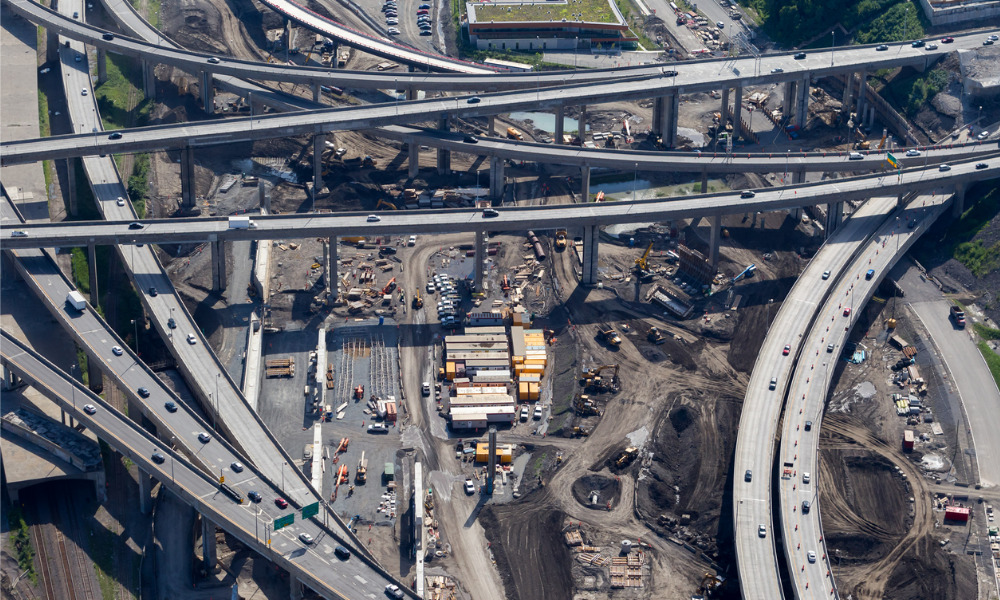Inflation, the pandemic, supply chain issues, and changing attitudes about allocating risk between owners of infrastructure projects and those who build them are changing contract negotiations and dispute settlements, say lawyers who practise in this area of law.
Chris Bennett, chair of the national banking and financial services practice group at Osler Hoskin & Harcourt LLP, says that while COVID-19 isn’t solely responsible for current trends in infrastructure negotiations, it did highlight some “significant gaps” in putting together contracts.
The urge for more transparency in pricing models
For starters, the lack of a transparent regime to deal with COVID-like situations became evident, he says, as parties on both sides of the table realized that it didn’t fit into a “neat bucket” of how to determine compensation. Bennett says much pressure was put on many contractors to carry high costs. At the same time, there is growing sensitivity and understanding of the impact of international supply chain issues on the cost of infrastructure projects.
He says that builders are more concerned about locking into long-term arrangements that, in the long run, are only profitable with some mechanisms for flexibility.
On the other side, project owners and governments funding infrastructure are seeing developers and contractors not bidding on projects and, in some cases, even withdrawing from a fixed-price model. “The market has learned that the pricing of some of those projects didn’t take into account all the risk associated with a complicated project that could take years to complete,” he says.
Bennett says large complex projects are being broken up into “bite-sized” chunks based on the risk people are willing to take and the capital they can raise on projects.
“It’s going to be very interesting to see how this model evolves,” he says, “in terms of integrating these smaller components and dealing with disputes that might come up between the different parties.”
Changes in mechanisms for settling disputes
Roger Gillott, an Osler partner and prominent construction litigator based in Toronto, says he initially noticed the construction and infrastructure industry moving from mediation to arbitration as a tool for settling disputes. Now, many of our clients are moving back to the courts.
One of the reasons he cites is mandatory arbitration clauses in the construction contract and design contract that often do not provide for the consolidation of the two arbitrations. “As a result, if you are the owner, you end up with two separate arbitrations,” he says, one with the contractor and one with the engineer or architect, each likely blaming the other. This would be one lawsuit in court, and the court can apportion responsibility between the parties.
However, Gillott says recent case law has made it more difficult for clients to avoid arbitration if they don’t want it. And while adjudication under the Ontario Construction Act was heralded as a significant new development that would change construction disputes when the act and equivalent legislation in other provinces was amended a few years ago, there has been relatively little uptake, particularly on significant infrastructure projects.
Maxime Jacquin, a partner in the Montreal office of Stikeman Elliott LLP, agrees that it has been a “very challenging time in the infrastructure industry, given inflation, supply chain issues, rising interest rate costs, labour issues, and even the war in Ukraine.”
However, he adds that the industry has been resilient despite this “perfect storm” – “projects are happening, and governments are investing massively, especially when it comes to sustainable infrastructure.”
He adds that infrastructure projects’ funding and delivery model has been shifting toward more collaborative models such as progressive design-build, which spreads the risk more evenly between the public and private sectors than the traditional P3 model.
“The more collaborative models allow for better communication and a better appreciation of what factors are driving costs and how to make decisions that achieve the best value for money,” Jacquin says.
The ripple effects of market pressures
Annik Forristal, group head of McMillan LLP’s national infrastructure and construction group, says she is seeing the “ripple effects” of the market pressures in the infrastructure sector over the last couple of years.
“It is putting a lot of strain on projects, both those that are underway and those that are going out to tender.” She says contractors have difficulty recovering their costs under contracts that traditionally place many of these risks on them.
The result is that some projects are struggling to get off the ground, or a situation is created where there is only one bidder left on a project, going against the purpose of a competitive bidding process in that the project owner has only one party to negotiate with.
The response to this type of pressure, says Forristal, is more flexibility in negotiating how these projects are delivered. Contract wording has moved away more from fixed pricing to deal with price increases and more recognition of how supply chain issues can affect the completion time of a project.
Today, there’s also a better understanding that a one-size-fits-all model doesn’t work for all projects, Forristal says.
“How you deliver a project that involves a single structure on a contained site, like building a hospital, is very different from the risks and the challenges you’re going to face in building a linear project like a highway or an LRT when you’re going through dense urban corridors, and there are a lot more variables outside of your control,” she says.
She also notes that the balance of power in the owner-contractor relationship is shifting somewhat in favour of the contractor as more contracts adopt “costs plus” so that a contractor can get compensated for their actual costs.
Even fixed-price contracts are seeing more inclusion of escalation clauses or clauses tied to price indexes for construction or a particular component of a project, like steel or cement. If costs rise beyond a certain percentage from when a contract is signed to when the contractor buys the product, then such a clause provides an opportunity to increase the contract price.
Lampros Stougiannos, a partner with Dentons Canada in Ottawa whose practice focuses on infrastructure, public-private partnerships, and government contracting and procurement law, says the Pandora’s box has been opened when it comes to conversations around pricing models. “The initial reaction from players in the market to the fixed-price approach these days is, ‘Why can’t we do a progressive model?”
Given the pushback, Stougiannos says “everything is on the table” in terms of procurement models, from contractors and even from project owners who want to ensure good competition and participation in what he describes as a “tight market with a large volume of projects.”
With a progressive model, Stougiannos says contractors can be more confident that the pricing of a project reflects the cost of a project with a fair profit margin, “so it’s becoming a tool available in the toolbox.”
He adds that the final cost might also depend on priorities such as completion time. “If an on-time schedule is an absolute requirement, and you need to have a project online by a specified date, then maybe a project owner is willing to be more flexible on price, and perhaps you’re looking at more of a cost-plus model or a target price model to incentivize the contractor to work as quickly as possible and bring as many resources to bear on the project, knowing that they’re going to be paid for that.”
Another way to deal with rising costs and supply issues is for owners to agree on advance payments for materials ordered earlier. To save money on materials like steel, the contractor might suggest “buying it now rather than six months from now.” But this remedy also has budget implications, like where to store the material and who pays for that storage.
Big country, small market and impact on infrastructure
Ian Michael, who practises corporate and securities law at Bennett Jones LLP, emphasizing mergers and acquisitions involving private equity investments and public companies, says he has seen this strategy in action.
“We’ve had proactive project developers that have forced their contractors to purchase, for example, pipeline steel or other components for their project in advance and warehouse them,” he says.
“What you’re doing is trading longer-term cost volatility with upfront investment. So, if your financing and project budget allows you to make that investment upfront and sit on that investment for some time, plus warehousing costs, you may be ahead of the game.”
Michael also notes that it isn’t just about the commodity price. Foreign exchange rates can often have an even more significant cost impact.
He also brings up the increasingly tricky experience that contractors and subcontractors have in getting the skilled labour they need to complete projects promptly and cost-effectively.
“Canada is a big place geographically, but a relatively small market,” Michael says, “so one mega project in this ecosystem moves the needle, absorbing resources from a pretty large area.”
A large pipeline or LNG project can “suck up huge amounts of labour and engineering expertise that would otherwise be available to other smaller projects in that same jurisdiction, and even an entire industry can get affected by a small number of mega projects.
“It is a national issue in terms of our ability to deliver important infrastructure projects that drive economic development, that drive productivity, that move Canada ahead and keep us competitive,” Michael says. “Not having the people to actually get things done is just as much an impairment as regulations that hold us back.”





